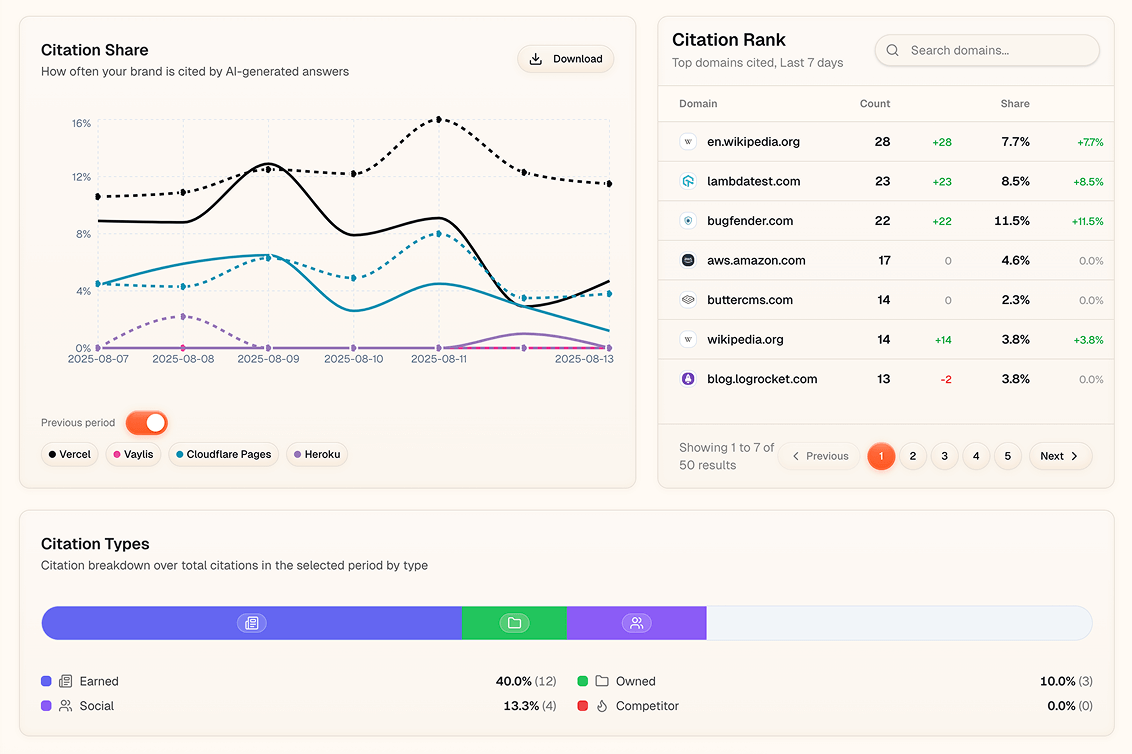The Multi-Engine Reality
The search landscape has fragmented. Users no longer rely on a single search engine. They ask ChatGPT for recommendations, Perplexity for research, and Google for traditional searches.
Yet most brands still optimize only for Google. This is like having a website that only works on Internet Explorer.
Why Multi-Engine Matters
1. User Behavior Has Changed
Search is now multi-platform:
- ChatGPT: For conversational queries and recommendations
- Perplexity: For research and fact-checking
- Google AI: For comprehensive search experiences
- Bing AI: For integrated web and AI search
- Specialized AI: For domain-specific queries
2. Algorithm Diversity
Each AI engine has different:
- Data sources and recency preferences
- Citation evaluation criteria
- Content type preferences
- User intent interpretations
3. Risk Mitigation
Relying on one platform is risky. Algorithm changes, policy updates, or platform shifts can devastate your visibility.
The Major AI Search Platforms
1. ChatGPT (OpenAI/Microsoft)
Strengths:
- Massive user base and engagement
- Strong in conversational, recommendation queries
- Values comprehensive, well-written content
- Good at synthesizing information
Optimization Focus:
- Natural language content
- Conversational question answering
- Brand storytelling and narrative
- Comprehensive topic coverage
2. Perplexity
Strengths:
- Real-time information synthesis
- Strong fact-checking and source verification
- Academic and research-oriented
- Transparent source citations
Optimization Focus:
- Data-driven content
- Source credibility and freshness
- Research and analysis content
- Factual accuracy and verification
3. Google AI (Bard/Gemini)
Strengths:
- Integration with traditional search
- Local and geographic expertise
- Rich multimedia understanding
- Comprehensive knowledge base
Optimization Focus:
- Traditional SEO signals still matter
- Local and geographic content
- Visual and multimedia content
- Structured data and schema
4. Bing AI (Copilot)
Strengths:
- Integration with Microsoft ecosystem
- Real-time web integration
- Creative and productivity focus
- Enterprise and professional users
Optimization Focus:
- Professional and business content
- Integration with Microsoft services
- Productivity and workflow content
- Technical documentation
5. Claude (Anthropic)
Strengths:
- Strong in analysis and reasoning
- Ethical and safe content preferences
- Research and academic content
- Long-form content processing
Optimization Focus:
- In-depth analysis content
- Ethical and responsible messaging
- Academic and research materials
- Comprehensive explanations
Multi-Engine Optimization Strategy
1. Content Platform Matrix
Create a content distribution matrix:
| Content Type | ChatGPT | Perplexity | Google AI | Bing AI | Claude |
|---|---|---|---|---|---|
| Blog Posts | High | Medium | High | Medium | Medium |
| Research Reports | Medium | High | Medium | High | High |
| Video Content | Low | Low | High | Medium | Low |
| Infographics | Medium | Medium | High | Low | Low |
| Case Studies | High | Medium | High | High | Medium |
2. Platform-Specific Content Adaptation
Tailor content for each platform's preferences:
For ChatGPT:
- Conversational tone
- Story-driven narratives
- Question-and-answer format
- Personal and relatable content
For Perplexity:
- Data-heavy content
- Source citations and references
- Factual accuracy focus
- Research methodology transparency
For Google AI:
- Traditional SEO optimization
- Rich snippets and structured data
- Local and geographic relevance
- Multimedia integration
3. Cross-Platform Content Syndication
Develop content that works across platforms:
- Modular content components
- Platform-specific optimizations
- Consistent branding and messaging
- Cross-platform linking strategies
Technical Optimization Strategies
1. Structured Data and Schema
Implement comprehensive schema markup:
{
"@context": "https://schema.org",
"@type": "Article",
"headline": "Your Article Title",
"author": {
"@type": "Person",
"name": "Author Name"
},
"publisher": {
"@type": "Organization",
"name": "Your Brand"
}
}
2. Content Freshness Signals
Keep content current across platforms:
- Regular content updates
- Real-time data integration
- Social proof and engagement
- Cross-platform content refresh
3. Platform-Specific Technical SEO
Optimize for each platform's crawling and indexing:
- XML sitemaps for all platforms
- Platform-specific robots.txt
- Content formatting preferences
- API integrations where available
Content Strategy for Multi-Engine Success
1. Pillar-Cluster Content Architecture
Build interconnected content ecosystems:
- Pillar Content: Comprehensive topic overviews
- Cluster Content: Specific sub-topic deep dives
- Cross-linking: Internal citation networks
- Platform Distribution: Tailored presentation
2. Question-Based Content Creation
Structure content around user questions:
- Identify platform-specific query patterns
- Create comprehensive answer content
- Build question clusters and series
- Optimize for conversational search
3. Authority Building Across Platforms
Develop platform-specific authority signals:
- Platform-specific backlinks and citations
- Social proof and engagement metrics
- Expert contributions and endorsements
- Platform-native content formats
Measurement and Analytics
1. Multi-Platform Visibility Tracking
Monitor presence across all platforms:
- AI visibility scores by platform
- Citation tracking and analysis
- Brand mention monitoring
- Sentiment analysis
2. Cross-Platform Attribution
Understand the customer journey:
- Platform discovery attribution
- Cross-platform content performance
- Conversion path analysis
- Multi-touchpoint optimization
3. Platform-Specific KPIs
Track platform-unique metrics:
- ChatGPT: Conversation engagement
- Perplexity: Source citation frequency
- Google AI: Traditional ranking metrics
- Bing AI: Integration performance
Tools for Multi-Engine SEO
1. AI Visibility Platforms
Comprehensive monitoring tools that track multiple AI engines simultaneously.
2. Platform-Specific Analytics
Dedicated tools for each major platform:
- ChatGPT analytics and insights
- Perplexity citation tracking
- Google Search Console for AI features
- Bing Webmaster Tools
3. Content Management Systems
Platforms that support multi-platform publishing and optimization.
Implementation Roadmap
Phase 1: Audit and Planning
- Assess current multi-platform presence
- Identify platform priorities and opportunities
- Set up monitoring and analytics
Phase 2: Content Optimization
- Optimize existing content for multiple platforms
- Create platform-specific content variations
- Implement technical optimizations
Phase 3: Advanced Strategies
- Develop platform-specific content strategies
- Implement automated distribution systems
- Build cross-platform authority networks
The Competitive Advantage
Brands that master multi-engine SEO gain several advantages:
1. Risk Diversification
No single platform dependency reduces risk.
2. Audience Expansion
Reach users across different search behaviors and preferences.
3. Authority Amplification
Cross-platform citations create compounding authority effects.
4. Future-Proofing
Adaptability to new AI search platforms as they emerge.
Common Pitfalls to Avoid
1. Platform Silos
Don't create completely separate content for each platform.
2. Google-Centric Thinking
Avoid assuming all platforms work like Google.
3. Content Duplication
Don't publish identical content across platforms.
4. Neglecting Traditional SEO
Google AI still matters for many users.
The Future of Multi-Engine SEO
1. AI Platform Consolidation
Some platforms may merge or dominate.
2. New Platform Emergence
New AI search platforms will continue to launch.
3. Cross-Platform Integration
Seamless experiences across multiple AI platforms.
4. Automated Optimization
AI tools that automatically optimize for multiple platforms.
Getting Started
Begin with your most important platforms and expand systematically:
- Choose Priority Platforms based on your audience
- Audit Current Presence across selected platforms
- Optimize High-Impact Content first
- Implement Monitoring and measurement
- Scale Successful Strategies across platforms
Multi-engine SEO isn't optional anymore - it's essential for brands that want to remain visible in the AI search era.
Frequently Asked Questions
Which AI search platforms should I prioritize first?
Start with ChatGPT and Perplexity due to their large user bases and citation influence. Then expand to Google AI for traditional search integration and specialized platforms based on your industry.
How do AI platform algorithms differ?
Each platform has unique data sources and evaluation criteria. ChatGPT favors comprehensive content, Perplexity prioritizes factual accuracy, Google AI considers traditional SEO signals, and Bing AI focuses on enterprise integration.
Can I use the same content across all platforms?
Use consistent messaging but adapt presentation for each platform's preferences. ChatGPT prefers conversational content, Perplexity needs data-heavy material, Google AI responds to structured data.
How do I measure multi-platform success?
Track visibility scores, citation frequency, and brand mentions across platforms. Monitor conversation engagement for ChatGPT, source citations for Perplexity, and traditional metrics for Google AI.
What's the biggest challenge in multi-engine SEO?
Managing different optimization requirements while maintaining brand consistency. Each platform rewards different content types and citation patterns.
How often should I update multi-platform strategies?
Review performance monthly and adjust strategies quarterly. AI platforms update frequently, so continuous monitoring and adaptation are essential.
Do I still need traditional SEO?
Yes, traditional SEO provides the foundation for AI visibility. Google AI still considers traditional ranking factors, and strong SERP performance influences AI citations.



